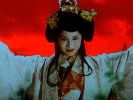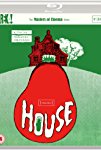Eye For Film >> Movies >> House (1977) Film Review

"You didn't tell me that we were supposed to take drugs before we started watching this film," protested Eye For Film's Stuart Crawford as we viewed this. Strictly speaking, the drugs aren't necessary. You could have been a teenager in Japan in the late Seventies, or you could just have a love of the unusual in cinema. Whichever is the case, you won't find much else out there like House, a film that revolutionised Japanese cinema in its day and still confounds audiences now.
For all its strangeness, House is built around a rather old-fashioned story. Teenager Angel (played by Kimiko Ikegami and referred to in some versions as Gorgeous) is resentful when her widowed father chooses to remarry so, instead of spending her summer holidays with him as usual, she chooses to take along six of her friends and travel to the remote home of an aunt (Yoko Minamida) whom she hasn't seen for many years. Prof (Ai Matsubara), Melody (Eriko Tanaka), Kung Fu (Miki Jinbo), Mac (Mieko Sato), Sweetie (Misayo Miyako) and Fantasy (Kumiko Ohba) are happy, lively girls looking forward to a summer of fun, but Angel's aunt has a secret. There's a reason why she wears dark glasses in the sunshine, has a strange connection with a blue-eyed cat and starts to look younger as, one by one, the girls begin to disappear.

To get a handle on the rest of what happens, one needs to realise that many of the horrors encountered by the girls stem from the imagination of director Nobuhiko Ôbayashi's then 11-year-old daughter. There's a child-like logic to much of what unfolds. A reflection that reaches out from a mirror to consume the viewer. A piano that eats the player's fingers. Special effects are put together like collage, snipped-off body parts floating around the screen over bright, primary-coloured backgrounds. The cat's eyes sparkle like an early computer game animation and Ôbayashi wisely eschews any attempt to pass this off as realistic. It's hyper-real, growing more absurd with each passing moment. What might once have passed as a conventional Japanese haunted house is illuminated like a disco, and Auntie dances in the air like a cannibal Mary Poppins.
Watermelon introduce sexual innuendo but the story is told very much from the girls' perspective, with all the immediacy and urgency that entails. The pace is frenetic (older viewers may find it exhausting), the camera moving from traditional theatrical-style framing to extreme close-up in seconds and many scenes shot from behind pillars, pipes or frames so that the action is partially obscured. Ôbayashi, whose background was in advertising, places adverts blatantly in shot and also delivers pastiche of many of their techniques, both visually and musically. The influence of the resulting film on modern Japanese teen culture has been considerable.
A not insignificant proportion of viewers will find House completely unwatchable. Others will adore it. It is a true original of considerable historical importance. It's gory, silly, at times splendidly incoherent, and yet possessed of a fairy tale innocence. If you watch it in the right mood, you might not need the drugs.
Reviewed on: 10 Feb 2018
















